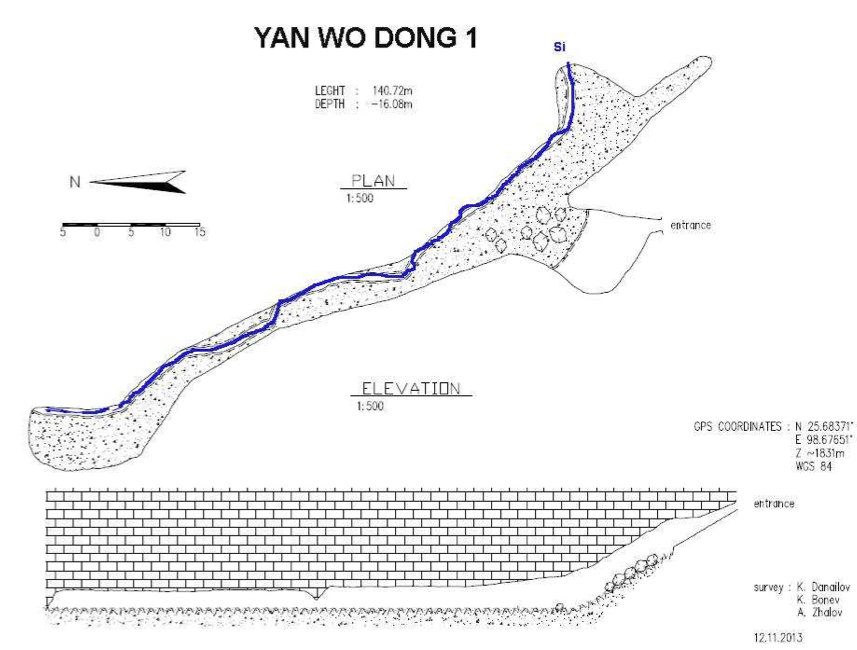
Grottes et karsts de Chine
Sur les traces de Xu Xiake
 Yanwodong 1 -
Yanwodong 1 -
Détail
Province, Préfecture, District :
Yunnan 云南省, Baoshan 保山, Tengchong 腾冲县
Latitude Nord - Longitude Est :
25.68371 - 98.67651
Altitude (m) : 1831
Développement (m) : 141
Profondeur (m) : 16
Profondeur - / + (m) : 16 /
Volume (m3) :
Carte
Description 1
Coordinates: N25.68371 E98.67651
Length: 140.72 m Depth: 16.08 m
The cave is located 1.330 km S-SW from the Dapojiao Vill and 0.270 km from the Yaoqing Vill. at 1831 m a.s.l.) The cave is developed along a fissure with direction NW. The entrance is 3.50 m wide and 1.40 m high. The entrance passage is 27 m long with inclination – 59°. Its width is about 10 m. The height varied from 1.40 in the beginning but grow to 9.40 in the end of the passage. The floor is covered by stone boulders. The passage leads to perpendicular gallery where the little stream is running. Upstream part is 80 m long. Its width varied from 9 m in the beginning further become 4 m . The passage ended with enlarging so the gallery becomes about 9 m wide. The high is from 2.50 to 3.80 m. The passage ended with muddy sump. The passage downstream is 38 m long between 7.70 and 3 m wide. It ended by funnel formed in the clay which covered all ground of the cave. The underground stream sinks in the bottom of the funnel – swallow hole! The temperature of the air of the cave is 16.8oC.
Alexey Zhalov edited by, Chinese-bulgarian speleological expedition “Gaolingongshan 2013” in Yunnan province, China. (2016)
Gaoligonshan 2013 Expedition Report - Editors : Alexey Zhalov & Boyan Petrov. Description of the caves: Alexey Zhalov. Photos: Alexey Zhalov, Boyan Petrov, Zhang Fan. Edition of © Bulgarian Caving Society , November 2016.
Analyse :
This report details the joint Chinese-Bulgarian expedition carried out by members and friends of Bulgarian Caving Society in collaboration with the Yunnan Institute of Geography & China Exploration & Research Society (CERS)- Yunnan branch. The primary aim of the 2013 joint Chinese-Bulgarian expedition was to continue the exploration of caves in Gaoligongshan Mountain and some unexplored adjacent areas in Yunnan Province of China. Six speleologists from Bulgaria and four from China took part in the survey carried between 4 and 14th November 2013. During the expedition 14 caves with total length of 2302.60 m and depth of 379.06 m were studied and mapped. Xian Ren Dong next to MengnuozСen village was the most significant cave explored by the team. Its length was measured to be 1863.70 m. Rich cave-dwelling fauna was collected from 6 of the caves and three species of carabid beetles was proved and described as new to science.
1067 caractères - Lu 116 Fois
Bibliographie 1
Alexey Zhalov edited by, Chinese-bulgarian speleological expedition “Gaolingongshan 2013” in Yunnan province, China. (2016)
Gaoligonshan 2013 Expedition Report - Editors : Alexey Zhalov & Boyan Petrov. Description of the caves: Alexey Zhalov. Photos: Alexey Zhalov, Boyan Petrov, Zhang Fan. Edition of © Bulgarian Caving Society , November 2016.
This report details the joint Chinese-Bulgarian expedition carried out by members and friends of Bulgarian Caving Society in collaboration with the Yunnan Institute of Geography & China Exploration & Research Society (CERS)- Yunnan branch. The primary aim of the 2013 joint Chinese-Bulgarian expedition was to continue the exploration of caves in Gaoligongshan Mountain and some unexplored adjacent areas in Yunnan Province of China. Six speleologists from Bulgaria and four from China took part in the survey carried between 4 and 14th November 2013. During the expedition 14 caves with total length of 2302.60 m and depth of 379.06 m were studied and mapped. Xian Ren Dong next to MengnuozСen village was the most significant cave explored by the team. Its length was measured to be 1863.70 m. Rich cave-dwelling fauna was collected from 6 of the caves and three species of carabid beetles was proved and described as new to science.
Source :
Images 0
Topographie 1

Source : FBS/CERS/YIG
Expédition 1
Cette grotte a été identifiée ou explorée au minimum par cette (ces) expédition (s) :
Recherche